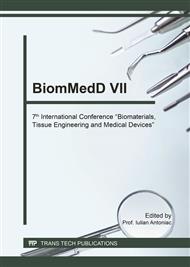p.35
p.41
p.49
p.54
p.59
p.64
p.71
p.81
p.87
Synthetic Mesh Used in Gynecologic Reconstructive Surgery for Pelvic Floor Disorders
Abstract:
Pelvic floor disorders including stress urinary incontinence and pelvic organ prolapse represent a challenge for gynecologist or urogynecologist even nowadays. Conservative treatment for these conditions proves its effectiveness only in few cases selected from early forms of incontinence or prolapse the most cases being solved surgically. The introduction of the procedure imagined by Petros and Ulmsten, known as TVT (Trans Vaginal Tape) in which the medium urethra is supported by a synthetic tape produced in 1996 a revolution in the surgical treatment of stress urinary incontinence. Radical changes also appeared in pelvic organ prolapse surgery extrapolating the hernia repair procedure by using synthetic mesh. After nearly 20 years of experience the mesh surgery is today a common practice in urogynecology. Between 2011 and 2015 we operated in private practice a total number of 297 cases of which 187 cases of stress urinary incontinence and 110 cases of pelvic organ prolapse. From these 86 (78,1%) cases were represented by cystoceles, associated with early apical prolapse or rectoceles, 18 (16,3%) cases by apical prolapse (grade III-IV) and 6 (5,4%) cases by posterior compartment prolapse alone. We performed mesh surgery in 32 (29%) cases represented mainly by anterior compartment prolapse. In 6 (18,7%) cases we founded mesh extrusion which required partially resection. In two cases we performed large resection of anterior vaginal wall required grafting with acellular second generation graft. In all cases with mesh extrusion the biomechanical analysis revealed significant decrease in effective porosity of the mesh due to excessive tensioning or folding of the mesh. The use of mesh in stress urinary incontinence and pelvic organ prolapse represent a justified alternative in selected cases. The specific complications due to meshes are more frequent in prolapse surgery compared to stress urinary incontinence. In all cases altered effective porosity due to technical defects in surgery represents the leading cause.
Info:
Periodical:
Pages:
59-63
Citation:
Online since:
August 2017
Price:
Сopyright:
© 2017 Trans Tech Publications Ltd. All Rights Reserved
Share:
Citation:


